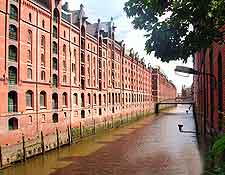Hamburg History Facts and Timeline
(Hamburg, Germany)

Hamburg has a rich history that extends back to the 9th century AD. The first permanent settlement here took the form of a fortress, which was called Hammaburg. It was built on the orders of Emperor Charlemagne and was situated on land between the rivers Elbe and Alster.
The fortress served as a focus for Christian missionaries. Most notably, in 834 AD, its first bishop was appointed. Hamburg was subject to many attacks at this time. In particular, Viking raiders came here in 845 AD, wreaking havoc. Sometime later, in the 11th century, the King of Poland set fire to the city.
From Medieval Times to the Reformation
In 1189, Emperor Friedrich I, commonly known as 'Barbarossa', granted Hamburg the right to become an Imperial Free City. It quickly established the city as a major port and led to the foundation of merchants' guilds here.
In the 14th century, Hamburg joined the Hanseatic League, an alliance of cities and their merchant guilds that allowed them to dominate trade in northern Europe. Consequently, the city's fortunes improved considerably, bringing even more opportunities. The city created its own navy in the early 15th century and was able to maintain its Hanseatic trading privileges.
Hamburg embraced the German Reformation of the 16th century. In 1531, the city's cathedral chapter was closed, reopening again in 1540 as a Lutheran establishment. Many Jewish and Protestant people sought refuge here and, in turn, the city expanded to accommodate these new settlers.
History from the 18th Century Onwards
In 1762, Hamburg was occupied by the Danes, albeit for a brief time. Then, during the early years of the 19th century, the city fell into the hands of the French Emperor, Napoleon. From 1814 to 1866, it became part of the German Confederation.
During the second half of the 19th century, Hamburg grew at an astonishing speed. In the mid-1800s, a stock exchange opened here. The year of 1867 saw the city join the North German League. Then, in 1888, it joined the German Customs League. These proved to be important moves for the city, helping to make it Germany's gateway to the world. The Speicherstadt (Warehouse District) and the Rathaus (Town Hall) are both seen as symbols of this optimistic period of the city's history.
When World War One reared its ugly head, thousands of the city's men went to war, and sadly many never returned. A wartime blockade of the city cut it off from world trade. Nevertheless, the city recovered during the decade that followed, attracting many shipping companies. In 1919, the University of Hamburg was founded. Under the Third Reich, Hamburg had to give up its status as a free city. The Greater Hamburg Decree of 1937 incorporated several towns from the surrounding area into the city.
During World War Two, Allied bombing raids caused considerable damage. Almost half of the city's industrial areas were reduced to ruins, together with roughly 80 percent of its harbour district. In April 1945, Hamburg surrendered and was occupied by British forces. In 1946, a new council was elected.
The post-war period was not without its troubles. In 1962, a terrible storm hit, ruining most of the old part of the city. Many buildings were flooded and around 300 people died. Since reunification, Hamburg has worked towards becoming one of the largest deep-sea ports in northern Europe.
 Hamburg has a rich history that extends back to the 9th century AD. The first permanent settlement here took the form of a fortress, which was called Hammaburg. It was built on the orders of Emperor Charlemagne and was situated on land between the rivers Elbe and Alster.
Hamburg has a rich history that extends back to the 9th century AD. The first permanent settlement here took the form of a fortress, which was called Hammaburg. It was built on the orders of Emperor Charlemagne and was situated on land between the rivers Elbe and Alster.